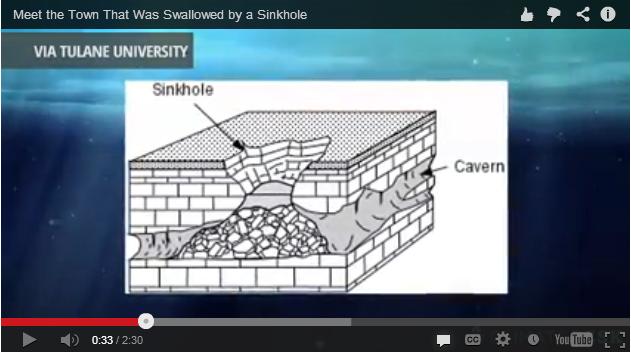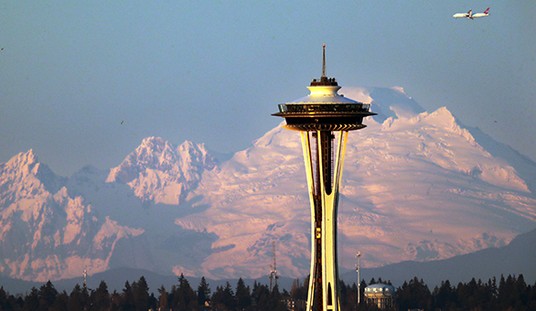Scientifically illiterate and agenda-driven journalists can ruin what is actually a valid story. Today’s example is the coverage of the Bayou Corne sinkhole, an ongoing environmental situation of considerable concern at the Napoleonville Salt Dome in Assumption Parish, Louisiana. About 350 residents of the quiet community of Bayou Corne have been evacuated from their homes since the sinkhole’s sudden formation nearly a year ago.
Local coverage of the sinkhole has been somewhat perfunctory, and national stories almost nonexistent. The sinkhole has not claimed any lives collapsed any structures. The only casualties so far have been a few cypress trees. “If it bleeds, it leads” seems to explain the sinkhole’s low profile in the press, despite the notable presence of Erin Brokovitch, every plaintiff’s favorite paralegal.
But this week a new video caught the media’s (and the public’s) attention — over four million views and counting. The video, hosted on the Assumption Parish Police Jury youtube account, shows a stand of cypress trees (looks to me like 6 to 8, not 25) being suddenly sucked into the sinkhole, as the ground underneath them fails and sloughs off into the deep. Writer Elizabeth Barber contributes this description for the Christian Science Monitor:
The sinkhole first bubbled and trembled last June, and then about two months later caved in, swallowing about 24 acres of land. Ever since, the giant swamp thing has occasionally sighed and heaved, pulling down more brush and trees and dirt. The latest video, though, in which 25 trees bid their adieu to sunlight, is the first footage of its machinations.
RECOMMENDED: Are you scientifically literate? Take our quiz
Sinkholes form when underground acidic water dissolves limestone until a cave is formed. The acid keeps eating away at the rock until the weight of the overlying landscape collapses the cave roof. On the surface, all looks well and calm until that cataclysmic point of no return is reached. Then the ground plummets downward, like a monster plunging into the foreground and breaking the dramatic silence of a horror film.
[Note: Emphasis added. Irony and turgid prose in original. – Ed.]
Actually, another video from over a month ago is less dramatic but perhaps more troubling. Water is not supposed to move like this in quiet Louisiana lakes and bayous:
[youtube=http://youtu.be/73QZ7oL37ls]
That yellow boom is in place to contain crude oil that occasionally bubbles up from below.
A common mistake that journalists make is to equate the Bayou Corne sinkhole with other sinkholes that make the news, like the recent one in Florida that catastrophically collapsed part of a resort building. That’s the key scientific mistake Ms. Barber makes in the passage quoted above, and the misrepresentation that Mother Jones’ Tim Murphy makes in using a graphic depiction of the same process in his video:
The Bayou Corne sinkhole has nothing at all to do with limestone and acidic ground water. More on that in Part II.
The title of Murphy’s article (“Meet the Town That’s Being Swallowed by a Sinkhole“) pretty much lays out the narrative template he chooses to follow, facts and science be damned.
That’s a 2012 image; as we shall see in Part II, the sinkhole has grown since then, but still does not threaten to “swallow” the town.
Murphy does make one assertion I agreed with at first reading:
Bayou Corne is the biggest ongoing industrial disaster in the United States you haven’t heard of.
But then I thought of the Hanford Site in Washington State, which will have an ultimate cleanup cost several orders of magnitude larger than Bayou Corne. A key difference: Hanford is Uncle Sam’s doing, not private industry, not “miners”, not “frackers”.
Murphy continues:
In addition to creating a massive sinkhole, [Bayou Corne] has unearthed an uncomfortable truth: Modern mining and drilling techniques are disturbing the geological order in ways that scientists still don’t fully understand. Humans have been extracting natural resources from the earth since the dawn of mankind, but never before at the rate and magnitude of today’s petrochemical industry. And the side effects are becoming clear. It’s not just sinkholes and town-clearing natural gas leaks: Recently, the drilling process known as fracking has been linked to an increased risk of earthquakes. [Which at best reflects gross ignorance, and at worst an outright lie. – Ed.]
“When you keep drilling over and over and over again, whether it’s into bedrock or into salt caverns, at some point you have fractured the integrity of this underground structure enough that something is in danger of collapsing,” observes ecologist and author Sandra Steingraber, whose work has focused on fracking and injection wells. “It’s an inherently dangerous situation.”
The problem at Bayou Corne was created by a salt cavern that was created, not “drilled into”, in 1982 using an inadequate understanding of the subsurface structure of the Napoleonville Dome. Today’s technology has improved. Steingraber here offers zero science, just fear of the unknown. Her assertion is akin to suggesting that a patient could suffer a collapsed lung as a result of a flu shot.
As a resident of Louisiana, I started investigating the sinkhole situation to see if it is under control and that state regulators and Texas Brine are taking adequate steps to protect the environment. The news stories above fail to address the science, the response and the future outlook for the sinkhole; again, I hope to do that in Part II.
For the 350 residents of Bayou Corne, I can only imagine the frustration and the stress that goes along with their year-long ordeal. My heart goes out to them, and my prayer is for a quick resolution so that they can return to their homes and resume their lives.
To be continued . . .
















Join the conversation as a VIP Member